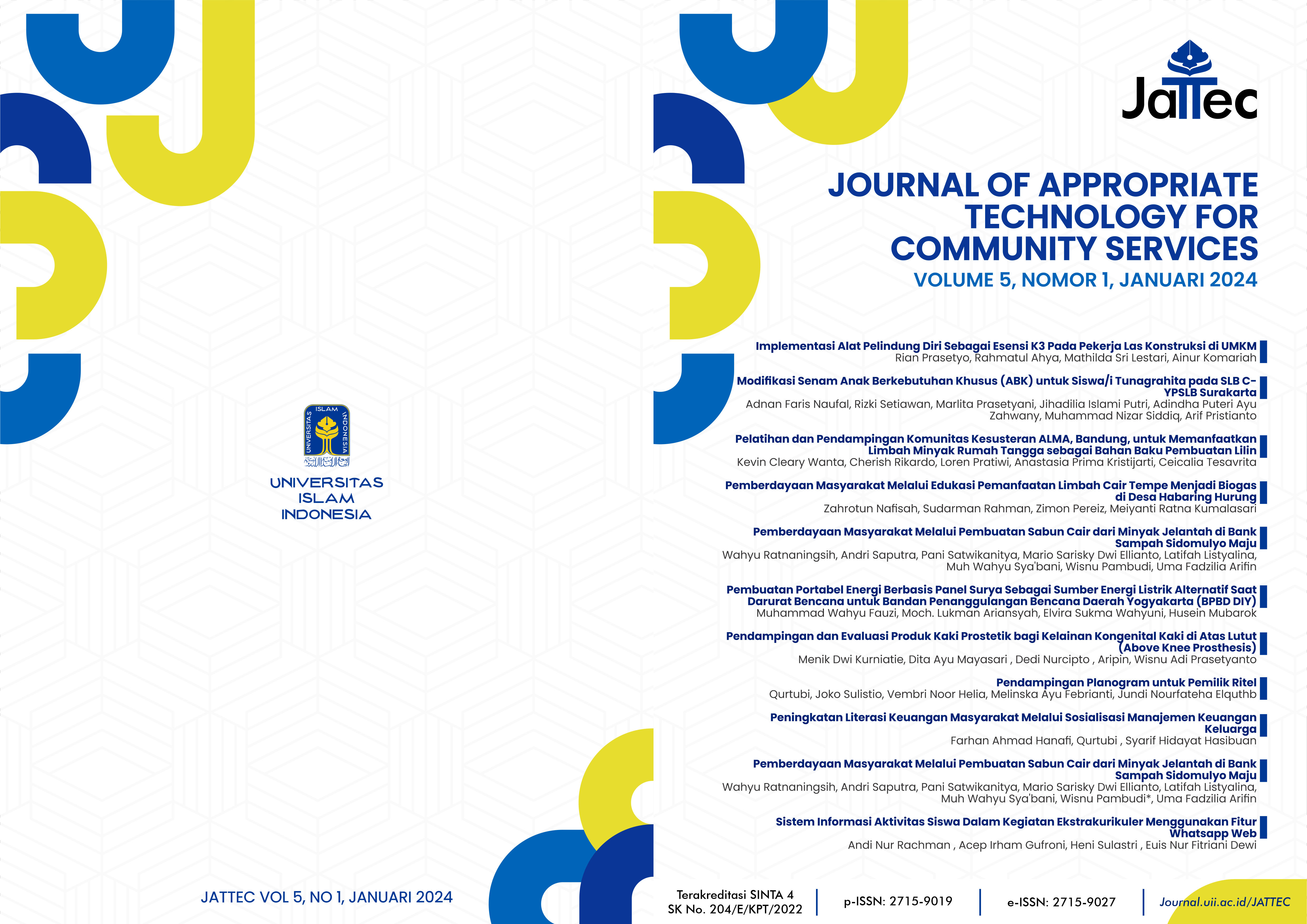Main Article Content
Abstract
Natural disasters are quite common in Indonesia, such as volcanic eruptions, tsunamis, earthquakes, and floods, this is because Indonesia is located between the three tectonic plates of the world (Indo-Australia, Eurasia and the Pacific). Disasters that often occur cause material losses such as damage to buildings and hamper the supply of primary needs, for example the need for electrical energy. The delay in the need for electrical energy after a natural disaster has caused the mobility of the community to be disrupted, for example lighting.The portable energy system that has been designed has proven to be quite effective in supplying electrical energy for the evacuation of victims of natural disasters. The test results show that portable energy can produce energy of 720Wh with a load scheme of using five 10Watt LED lights that operate for 12 hours/day and three charger stations operating for 4 hours/day. In the charging test using a solar panel with 120 Wp the device can be fully charged for 9 hours, but if the weather is cloudy, the solar panel cannot produce maximum power and results in less than optimal battery charge.Portable energy can have positive social and environmental impacts. Positive impact on the social sector, because it can provide a temporary supply of electrical power so that the electricity supply to the affected areas can operate normally.
Keywords
Article Details
References
- Adam, L. (2016). DINAMIKA SEKTOR KELISTRIKAN DI INDONESIA: KEBUTUHAN DAN PERFORMA PENYEDIAAN. Jurnal Ekonomi dan Pembangunan, 24(1), 29–41.
- Amri, Mohd. R., Yulianti, G., Yunus, R., Wiguna, S., W. Adi, A., Nur Ichwana, A., Evans Randongkir, R., & Tri Septian, R. (2016). Resiko Bencana Indonesia. BNPB.
- Nazaruddin, M. (2017). Jurnalisme Bencana di Indonesia, Setelah Sepuluh Tahun. Jurnal Komunikasi, 10(1), 79–88.
- Prasetiyo, B. (2018). ANALISIS PENGARUH INTENSITAS MATAHARI, SUHU PERMUKAAN & SUDUT PENGARAH TERHADAP KINERJA PANEL. 14(3), 78–85.
- Purwoto, B. hari, Jatmiko, J., Alimul, M., & Huda, I. F. (2018). Efisiensi Penggunaan Panel Surya Sebagai Sumber Energi Alternatif. Jurnal Teknik Elektro, 18(01).
- Ramadhan, D. W., Nakhoda, Y. I., & Agustini, N. P. (2020). Rancang Bangun Pembangkit Listrik Portable Tenaga Surya dan Angin Dengan Sistem Hybrid Untuk Tempat Pengungsian Bencana Alam. ALINIER, 1(2).
- Setyono, A. E., & Kiono, B. F. T. (2021). Dari Energi Fosil Menuju Energi Terbarukan: Potret Kondisi Minyak dan Gas Bumi Indonesia Tahun 2020 – 2050. Jurnal Energi Baru dan Terbarukan, 2(3), 154–162. https://doi.org/10.14710/jebt.2021.11157
- Sukma Wahyuni, E., Mubarok, H., Nur Budiman, F., & Wahyu Pratomo, S. (2020). Pemanfaatan Energi Terbarukan untuk Pembangkit Listrik Tenaga Surya Berbasis Komunitas: Menuju Desa Mandiri Energi. Engagement: Jurnal Pengabdian Kepada Masyarakat, 4(2). https://doi.org/10.29062/engagement.v4i2.181
- Widiharsa, F. A. (2006). KARAKTERISTIK PANEL SURYA DENGAN VARIASI INTENSITAS RADIASI DAN TEMPERATUR PERMUKAAN PANEL. 4, 232–242.
- Yudiartono, Y., Windarta, J., & Adiarso, A. (2022). Analisis Prakiraan Kebutuhan Energi Nasional Jangka Panjang Untuk Mendukung Program Peta Jalan Transisi Energi Menuju Karbon Netral. Jurnal Energi Baru dan Terbarukan, 3(3), 201–217. https://doi.org/10.14710/jebt.2022.14264
References
Adam, L. (2016). DINAMIKA SEKTOR KELISTRIKAN DI INDONESIA: KEBUTUHAN DAN PERFORMA PENYEDIAAN. Jurnal Ekonomi dan Pembangunan, 24(1), 29–41.
Amri, Mohd. R., Yulianti, G., Yunus, R., Wiguna, S., W. Adi, A., Nur Ichwana, A., Evans Randongkir, R., & Tri Septian, R. (2016). Resiko Bencana Indonesia. BNPB.
Nazaruddin, M. (2017). Jurnalisme Bencana di Indonesia, Setelah Sepuluh Tahun. Jurnal Komunikasi, 10(1), 79–88.
Prasetiyo, B. (2018). ANALISIS PENGARUH INTENSITAS MATAHARI, SUHU PERMUKAAN & SUDUT PENGARAH TERHADAP KINERJA PANEL. 14(3), 78–85.
Purwoto, B. hari, Jatmiko, J., Alimul, M., & Huda, I. F. (2018). Efisiensi Penggunaan Panel Surya Sebagai Sumber Energi Alternatif. Jurnal Teknik Elektro, 18(01).
Ramadhan, D. W., Nakhoda, Y. I., & Agustini, N. P. (2020). Rancang Bangun Pembangkit Listrik Portable Tenaga Surya dan Angin Dengan Sistem Hybrid Untuk Tempat Pengungsian Bencana Alam. ALINIER, 1(2).
Setyono, A. E., & Kiono, B. F. T. (2021). Dari Energi Fosil Menuju Energi Terbarukan: Potret Kondisi Minyak dan Gas Bumi Indonesia Tahun 2020 – 2050. Jurnal Energi Baru dan Terbarukan, 2(3), 154–162. https://doi.org/10.14710/jebt.2021.11157
Sukma Wahyuni, E., Mubarok, H., Nur Budiman, F., & Wahyu Pratomo, S. (2020). Pemanfaatan Energi Terbarukan untuk Pembangkit Listrik Tenaga Surya Berbasis Komunitas: Menuju Desa Mandiri Energi. Engagement: Jurnal Pengabdian Kepada Masyarakat, 4(2). https://doi.org/10.29062/engagement.v4i2.181
Widiharsa, F. A. (2006). KARAKTERISTIK PANEL SURYA DENGAN VARIASI INTENSITAS RADIASI DAN TEMPERATUR PERMUKAAN PANEL. 4, 232–242.
Yudiartono, Y., Windarta, J., & Adiarso, A. (2022). Analisis Prakiraan Kebutuhan Energi Nasional Jangka Panjang Untuk Mendukung Program Peta Jalan Transisi Energi Menuju Karbon Netral. Jurnal Energi Baru dan Terbarukan, 3(3), 201–217. https://doi.org/10.14710/jebt.2022.14264

